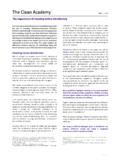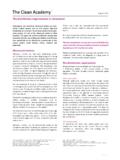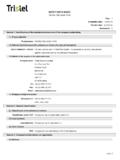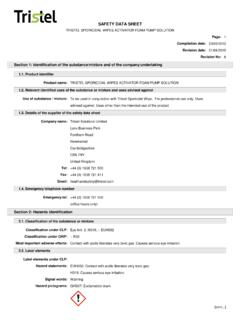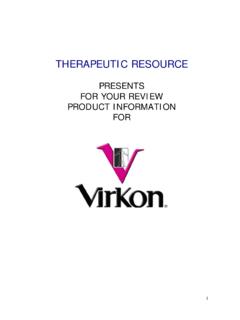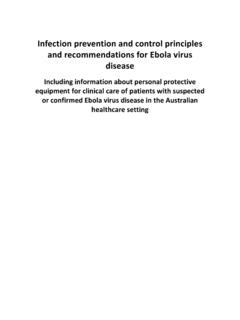Transcription of at of 35 43 ENT UK London WC2A 3PE - Tristel
1 At The Royal College of Surgeons of England 35 43 Lincoln's Inn Fields ENT UK London wc2a 3PE. Tel: 020 7404 8373 Fax: 020 7404 4200. Email: Web: Guidance on the decontamination and sterilization of rigid and flexible endoscopes Andrew C Swift 2010. ENT UK trading as British Academic Conference in Otolaryngology (BACO) and British Association of Otorhinolaryngology Head & Neck Surgery (BAO-HNS). Registered as a Company limited by Guarantee in England and Wales under Company No 06452601. Registered with the Charity Commission in England and Wales under Charity No 1125524. Guidance on the decontamination and sterilization of rigid and flexible endoscopes Key Recommendations 1 Following rigid and flexible endoscopy of the nose and throat, the endoscope will need to be cleaned and decontaminated to an acceptable standard.
2 At present the acceptable standard remains undefined and rests with individual hospitals. 2 It is most important to clean and remove any residual mucus, blood and debris from any endoscope that has been used in the nose and/or throat. This can be effectively achieved by hand with soap and water. 3 Chemical decontamination by chlorine dioxide has been widely used by many hospitals for several years and episodes of cross infection have not been reported. However, this system should be carried out according to a set protocol. There is no reason to discontinue this practice given the current state of knowledge. 4 Hospitals may still prefer to introduce central decontamination models to minimize the risk of cross infection. This is an expensive option and the hospital executive board members should be aware of the recurring costs involved before committing to this decision.
3 5 Whatever method of decontamination is chosen, there should be a robust system of endoscope traceability in place. 6 It is acknowledged that endoscope contamination with prions remains a serious potential risk but in the general population the risk is probably extremely low. 7 Should endoscopy be done on patients with suspected or known vCJD, the current advice from the DH is that the endoscope should be quarantined until the patient's vCJD status is known. If the patient is proved subsequently proved positive the endoscope should then be destroyed. 8 Currently, endoscope sheaths are not considered to provide sufficient protection in vCJD patients. 9 New, disposable flexible endoscopes that cost approximately 250 each should be available 10 There is no evidence to show that chlorine dioxide and/or sheaths lead to a greater risk of cross infection compared to processing endoscopes in central decontamination units.
4 The use of chlorine dioxide and/or sheaths should therefore be allowed to continue, even if used as a backup alongside central decontamination systems. 2. Guidance on the decontamination / sterilization of rigid and flexible endoscopes Introduction There has been increasing demand to minimise all risks of infection within the NHS. The decontamination of endoscopes has therefore come under scrutiny. There is currently no UK uniform system for decontaminating endoscopes used in ENT. practice. There is thus much variation in acceptable practice for the cleansing of endoscopes in both the NHS and private hospitals. Within ENT practice, guidance is required for three types of endoscope: rigid Hopkins rods, flexible nasendoscopes (including video-endoscopes) and flexible nasendoscopes with biopsy channels.
5 The current guidelines for endoscope decontamination have been based entirely on the standards set by gastroenterology, where endoscopes with biopsy channels are passed into the gastro-intestinal tract. However, most endoscopes used within ENT do not have biopsy channels and are not passed into highly contaminated areas. The greatest fear with regard to cross contamination is a prion-related disease such a vCJD. None of the decontamination systems, including autoclaving, is 100% effective at eradicating prions, but the risk of inducing disease is likely to be extremely low. However, the cost of processing endoscopes in a central decontamination unit is extremely expensive compared to the use of existing chemical wipes and sheaths. Current decontamination systems The infection control systems currently available include: chemical cleansing systems, endoscope sheaths, dedicated mechanical washing machines and autoclave sterilization.
6 The inevitable gold standard that large NHS Trusts support is central decontamination within designated decontamination units. This is because of their focus on minimising risk at all costs. Once one trust goes along this route, others will follow suite. However, this perceived minimization of risk is also the most expensive pathway for hospitals to take, and will require the purchase of a large supply of both rigid and flexible endoscopes. The least expensive is the use of chlorine dioxides wipes. This method has been used nationally for several years in many hospitals without any reported episodes of cross infection. The chlorine dioxide system is deemed inferior to central decontamination for various reasons, not least being the fact that an individual carries responsibility for washing the endoscope thoroughly and wiping down all surfaces.
7 However, there is no proof that any patient has suffered any harm from this process. Although several hospitals will already have committed themselves to central decontamination , the current financial situation within the country and the NHS means that funds have to be used wisely to ensure that other services do not suffer as a result of hospitals being over-diligent in their risk analysis of infection control. 3. Aims and Objectives The aims of this document are to provide information that should hopefully facilitate sensible but informed choices to be made on the decontamination of endoscopes in Otorhinolaryngology, Head and Neck surgery. The document is categorized into 3 sections for ease of reference: Section A lists a series of pertinent clinically useful questions and answers Section B provides information on the methods of endoscope decontamination and the standards that must be achieved.
8 Section C summarizes the key points with regard to the various decontamination models and the consequences for hospitals. 4. SECTION A. Relevant questions and risk analysis for ENT clinicians 1 Have there been any reported instances of an infection being introduced by endoscopy of the upper respiratory tract? There is no reported evidence to link the introduction of infection with endoscopy of the upper respiratory tract. This is true of both solid rigid endoscopes and flexible endoscopes. 2 What is the likely risk of prions being present within the nose? The overall risk of prions being carried within the ENT population is likely to be extremely low. The theoretical risk of contamination of an endoscope by prions being present within olfactory mucosa on the surface of the middle turbinate in an asymptomatic patient has been raised.
9 This risk is not proven and remains hypothetical. There is a risk of endoscopes being contaminated by tiny amounts of blood in a small number of patients. This is most likely in patients who undergo endoscopic nasal toilet after recent endoscopic sinus surgery. The risk of contamination from endoscopy is still likely to remain extremely low and highly improbable. 3 What action should be taken if an endoscope is used within the nose in a patient with suspected or known vCJD? The DH amended its recommendations in January 2010. Should an endoscope be used in a patient with suspected vCJD, the endoscope must be placed in quarantine until the condition is excluded. If the patient is subsequently shown to be positive for vCJD the endoscope should be destroyed.
10 Sheaths are not considered to offer sufficiently robust protection in this situation. A recent much cheaper alternative is the use of a disposable flexible endoscope ( ~. 250) Disposable endoscopes are now available for purchase and hospitals should be advised to keep some in stock. 4 Is it always necessary to have endoscopes freely available within ENT practice? The clear answer to this is that the risk of missing serious pathology such as tumours of the nose and throat is very real and highly likely if the correct endoscopic equipment is not available. This risk far outweighs the hypothetical risk and 5. extremely low probability of transfer of infection from an inadequately cleaned or contaminated endoscope to a patient. 5 Is there any evidence to suggest that the chlorine dioxide wipe system is ineffective?
